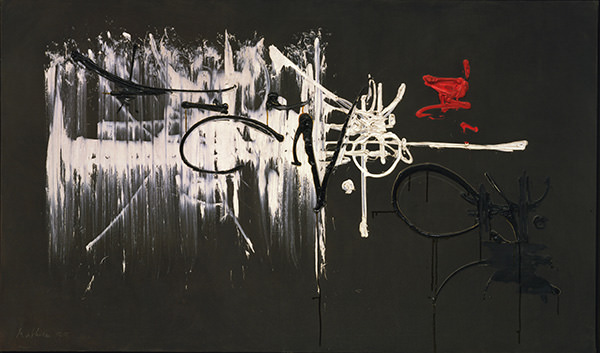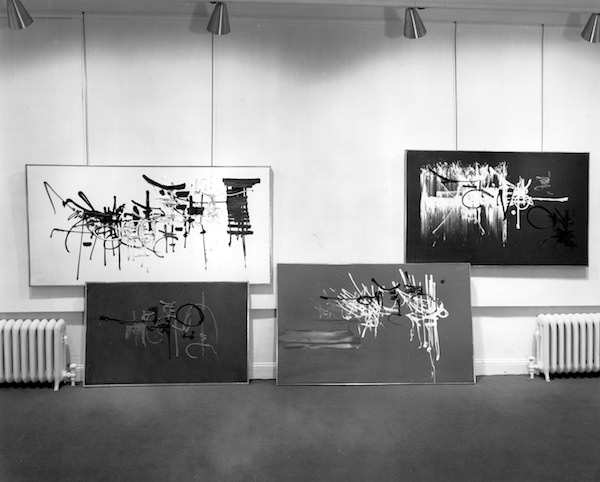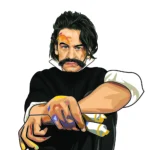Théorème d’Alexandroff (1955)
Théorème d’Alexandroff, which entered the MoMA’s collection in 1964, was painted in 1955 and exhibited as of 28 January 1956 at the Kootz Gallery in New York, one of 24 paintings that made up Georges Mathieu’s “epistemological” period.
Typical of Mathieu’s paintings in the 1950s, it exemplifies the energetic, rapid and intuitive calligraphy of distinct signs, often drawn directly using tubes of paint, which Mathieu pioneered in 1949. This technique, called “tubism”, which suppressed any intermediary between the artist and his creation, took over from the experimental techniques employed by Mathieu in the 1940s (such as the “dripping” used in Évanescence1Now belonging to the Fondation Gandur pour l’Art., a painting created in 1945).
This modernity did not prevent the use of a classical palette; in the case of Théorème d’Alexandroff, a near black and white duotone heightened by red, Mathieu’s favourite colours, with maximal effectiveness ensured by the use of a minimal number of colours, as much as by a reduced number of signs, which do not completely cover the canvas. As Christian Briend, head curator at the Centre Pompidou, has so rightly remarked, far from Pollock’s “all-over” principle, the characteristic of Mathieu’s works is “the balance of an always more or less centred construction” 2in Revue des musées de France, 2016, no. 2. and, in the present case, we may add, a form of hierarchy.
In Mathieu’s œuvre, the title was merely a “means of reference” 3in Cent questions discrètes et moins discrètes, interview by Alain Bosquet carried out at the end of 1958 and published in 1960 in the Ring des Arts magazine, reproduced in L’abstraction prophétique (Éditions Gallimard, 1984). preferable to simple numbering. Although he ruled out any influence on the creation of the paintings, apart from a few notable exceptions, the titles that he chose revealed his points of interest. In very many cases, they related to history. Here, science is concerned, the work fully falling within the “epistemological” period: epistemology is in fact the philosophical term describing the critical study of the sciences, their logical origin, their value and their reach. The work’s title refers to the mathematician Pavel Alexandroff, whose work Mathieu mentioned in an article tracing a parallel between the revolutions underway in the artistic and scientific fields.
However, if we are witnessing the collapse of all classical values in the field of art, a parallel and equally profound revolution is taking place in the field of the sciences (…) Ironically, the reincarnation of God is not happening through history, nor culture, nor art, but through science! (…) General topology as we know it today began with Hausdorff, within which Alexandroff and Urysohn defined compact spaces. Arriving at this culminating point, all of Western mathematics found itself abruptly ossified in a formalism of the purest logical tradition (Bourbaki School).4in Au-delà du Tachisme (Éditions Julliard, 1963), updated version of the article “D’Aristote à l’abstraction lyrique”, published in L’Œil, no. 52, April 1959.
The father of Lyrical Abstraction, of which Abstract Expressionism is the transatlantic counterpart, wandering the world in the 1950s in order to publicly paint enormous paintings in front of thousands of people, Georges Mathieu was at that time one of the most fashionable and commented-on European artists in the United States. Present in New York in 1949, at the Perspective Gallery for his first collective exhibition abroad, in 1952 during a solo exhibition organised at the Stable Gallery by Alexandre Iolas, and then represented by Samuel M. Kootz from 1954 to 1960, he was the subject of numerous articles, even in mainstream magazines and newspapers such as Time, Life and The New York Times.
Present from the 1950s in major public (Museum of Modern Art, Guggenheim Museum, Art Institute of Chicago, etc.) and private collections, Mathieu received enthusiastic accolades from the most eminent American art critics.
In The New York Times dated 9 November 1952, the art critic Stuart Preston noted: “Paintings by Georges Mathieu, one of the most fervid of contemporary French abstractionists, open the season at The Stable Gallery (…) Mathieu is a virtuoso of the brush.” 5Article reproduced in 50 ans de création (Éditions Hervas, 2003).
On 5 April 1954, in a long article, Time‘s critic affirmed that “Mathieu is an abstract expressionist as powerful as Willem de Kooning is for Manhattan.” 6in Catalogue of the 2002 and 2003 retrospective at the Galerie Nationale du Jeu de Paume in Paris, then at Salle Saint-Georges in Liège and, lastly, at Galleria Gruppo Credito Valtellinese in Milan.
As for Clement Greenberg, without a doubt among the most influential art critics of the post-war period, he considered Mathieu the strongest of European painters and the one whom he admired the most.
Right now (1959) I consider him the strongest of all new European painters.7in Clement Greenberg, Art and Culture, Critical Essays (Beacon Press, 1961).
To Georges Mathieu,
The Transatlantic painter I admire most.8Quoted by Mathieu in Le massacre de la sensibilité (Éditions Odilon Media, 1996).
The welcome Mathieu received in America would be echoed during the same decade by a tremendous reception in Japan, upon the invitation from professor Soichi Tominaga, the director of the National Museum of Western Art in Tokyo.
Fluent in English, simultaneously handling the public relations of the United States Lines shipping company
and its bilingual Paris Review, Mathieu was an important player in the relations between the European and American artistic scenes, when Paris was still the art world’s centre of gravity. He was the first to plan, around October-November 19489Galerie du Montparnasse, to exhibit the American Lyrical Abstraction artists alongside their Parisian counterparts. This objective was fully achieved in March 1951, in the context of the Véhémences confrontées10Galerie Nina Dausset, rue du Dragon, Paris. exhibition jointly organised by Mathieu and Michel Tapié, bringing together Bryen, Capogrossi, De Kooning, Hartung, Mathieu, Pollock, Riopelle, Russell and Wols. Mathieu confirmed his interest in American abstract painting by publishing a Déclaration aux peintres d’avant-garde américains in April 1952.
The relations between Georges Mathieu and the United States were many, but their detailed history remains
to be written, and their conclusions to be more widely disseminated: the artistic quality of his work and its historic importance. Some people are already working on this, let us hope that they succeed.
Édouard Lombard, director of Comité Georges Mathieu
This text was originally published in the catalogue “Two works from MoMA” by the Applicat-Prazan Gallery.
Références
| ↑1 | Now belonging to the Fondation Gandur pour l’Art. |
|---|---|
| ↑2 | in Revue des musées de France, 2016, no. 2. |
| ↑3 | in Cent questions discrètes et moins discrètes, interview by Alain Bosquet carried out at the end of 1958 and published in 1960 in the Ring des Arts magazine, reproduced in L’abstraction prophétique (Éditions Gallimard, 1984). |
| ↑4 | in Au-delà du Tachisme (Éditions Julliard, 1963), updated version of the article “D’Aristote à l’abstraction lyrique”, published in L’Œil, no. 52, April 1959. |
| ↑5 | Article reproduced in 50 ans de création (Éditions Hervas, 2003). |
| ↑6 | in Catalogue of the 2002 and 2003 retrospective at the Galerie Nationale du Jeu de Paume in Paris, then at Salle Saint-Georges in Liège and, lastly, at Galleria Gruppo Credito Valtellinese in Milan. |
| ↑7 | in Clement Greenberg, Art and Culture, Critical Essays (Beacon Press, 1961). |
| ↑8 | Quoted by Mathieu in Le massacre de la sensibilité (Éditions Odilon Media, 1996). |
| ↑9 | Galerie du Montparnasse |
| ↑10 | Galerie Nina Dausset, rue du Dragon, Paris. |







